Swamps, Bogs, Marshes and More!
Air Date: Week of October 14, 2022
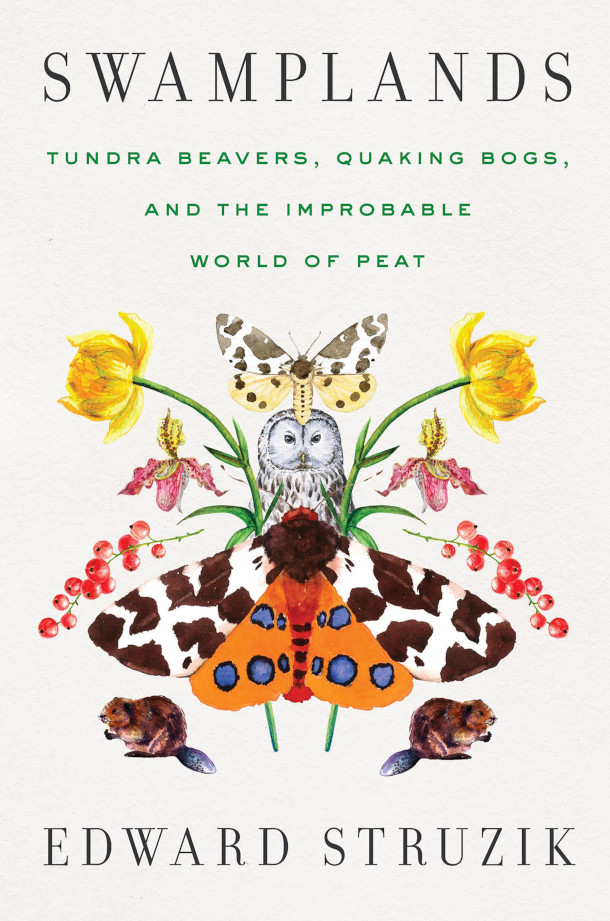
Edward Struzik’s 2022 book “Swamplands: Tundra Beavers, Quaking Bogs, and the Improbable World of Peat” (Photo: Courtesy of Island Press)
Swamps and bogs get a bad rap for their muck and biting insects. They’ve often been used as dumps for our garbage and drained for other uses. But today we understand that wetlands provide vital habitat and crucial flood protection. Author Edward Struzik set out to amend the reputation of these incredible ecosystems in his new book “Swamplands: Tundra Beavers, Quaking Bogs, and the Improbable World of Peat.” He joins Host Jenni Doering to discuss.
Transcript
BASCOMB: It’s Living on Earth, I’m Bobby Bascomb
DOERING: And I’m Jenni Doering.
For many of us swamps are not the most pleasant places, full of muck and biting insects. Historically, swamps, bogs, fens and marshes were often used as dumps for our garbage or drained to convert the land to other uses. But today we understand that wetlands are essential habitats for countless species and a crucial protection against storm surge and flooding from extreme weather events like hurricanes. Edward Struzik is author of the recent book “Swamplands: Tundra Beavers, Quaking Bogs and the Improbable World of Peat”. He joins me now for more on these essential and often overlooked ecosystems. Ed Struzik, welcome back to Living on Earth!
STRUZIK: Thanks for having me on.
DOERING: So you trekked and squelched through many different swamplands, or peatlands, to research this book. Could you bring to mind for us a particularly memorable one and help us picture what it would be like to be there? What does it sound like, smell like, feel like?
STRUZIK: Well, I think the first time I caught on to it was when I did a canoe trip on Banks Island, in the high Arctic, maybe about 400 miles northeast of Alaska. And it's situated in the Queen Elizabeth Islands, which is really a polar desert. It gets less than six inches of rain or snow each year. But as we started traveling down the river in the canoes trying to keep warm, we started seeing an awful lot of wildlife that we really didn't expect. For example, there were more than 80,000 muskox on the island, and that's two-thirds of the world's population on one island, which is absolutely extraordinary. We saw caribou, Arctic fox, Arctic wolves, Arctic hare, lemmings, there were rough legged hawks and peregrines nesting there. And I was just mesmerized by this and I was trying to figure out, well, “Why is this one island in the Arctic archipelago is so lush, when pretty much everything else is a polar desert?” And I realized the common denominator here is that there was a lot of peat, and it was three, four or five feet deep in places and, as every agriculturalist or gardener knows, peat is a wonderful medium for growth. And that was sort of the start off for the book.
Peatlands like Ponkapoag Bog in Massachusetts are waterlogged, acidic and oxygen-starved, which means organic matter doesn’t decay but becomes sequestered as peat (Photo: Louis Mallison)
DOERING: And what exactly is peat? What does it consist of?
STRUZIK: Well, peat is partially decayed vegetation that builds up over centuries. It comes with swamping that you get from deglaciation that happened 12,000 years ago. I mean, essentially, the conditions were just too wet. There was no oxygen and so everything that accumulated there, decayed vegetation, just built up over centuries. And that's essentially what it is and peatlands are basically bogs and fens that accumulate peat in waterlogged, oxygen-starved conditions.
DOERING: So as you write in your book, "Swamplands", these places are among the most biodiverse on the planet. What enables such dense biodiversity?
STRUZIK: They can be extremely biodiverse and part of it is is that you do have a lot of peat, which is a wonderful medium for growth. The other thing is that not a lot of people venture into these places because they tend to be extremely buggy, very wet, sloppy. They provide a wonderful refuge, because there are not a lot of people that inhabit peatlands, for reintroduction of endangered species such as the red wolf, you know, which, for reasons I cannot understand, you know, the gray wolf in Yellowstone gets so much publicity. But, you know, it's a Canadian animal and an American animal at the same time, the red wolf is quintessentially an American animal found nowhere else in the world. And it was functionally extinct in 1975 and had been successfully reintroduced to the peatlands in North Carolina and Virginia. And it's worked because there's enough food and not enough humans to prevent them from expanding their population. Humans are really not part of the equation in most cases.
DOERING: Yeah, tell us some of that story of how peatlands have featured in the human imagination and why they are sort of difficult places for us.
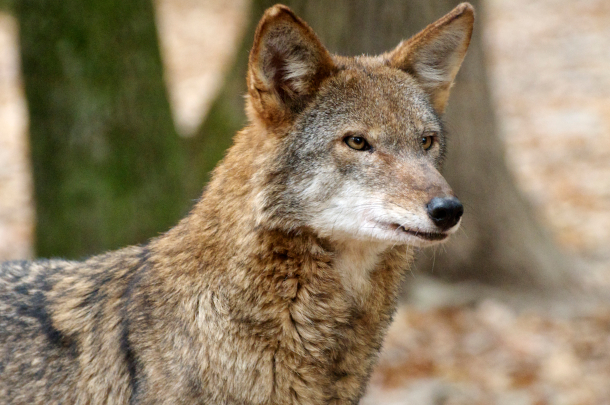
Unlike Gray Wolves, Red Wolves are only found in the United States (Photo: Paul Cooper, Flickr, CC BY-NC 2.0)
STRUZIK: You know, we inherited a lot of these myths about peatlands from Europeans, many of them believed in jack-o-lanterns: a man who had committed a crime and was left to wander the bogs at night. The smell, many people considered to be toxic, that it was the cause of diseases such as malaria and cholera. And this negative view of peatlands was brought to the new world, to the first Virginia colonies. But when George Washington came along, before he was President, he actually set up a company whose sole purpose was to drain the Great Dismal Swamp in North Carolina and Virginia, and he got actually Congress to invest in it.
DOERING: Wow.
STRUZIK: And what that does, when you dry out a peatland, is that it exposes all of that peat to air, it oxidizes, becomes extremely dry, and because you get a lot of tropical storms coming through there in the fall, a lot of thunderstorms, the lightning would ignite it, and it would burn for months and months and months. And so you had a combination of things drying up, fires making it worse, and this went on for more than a century.
DOERING: How have peatlands factored into indigenous life, and to what extent has that relationship really differed from the way that European colonizers and Americans viewed fens and bogs?
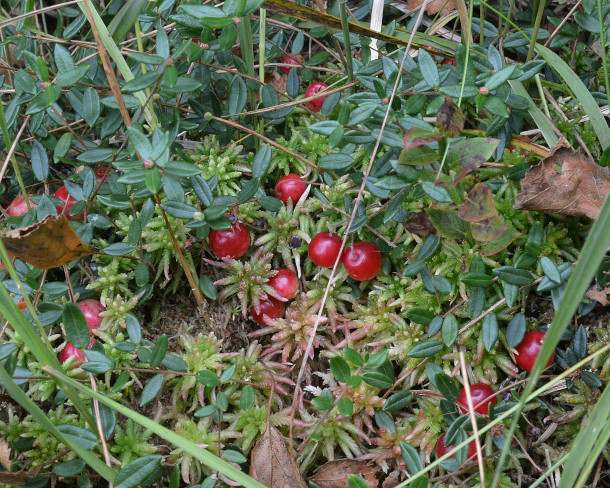
Cranberries growing among peat moss. Many plants of economic value grow in peatlands. (Photo: Ryan Hodnett, Wikimedia, CC BY-SA 4.0)
STRUZIK: Peatlands are where most cranberries, blueberries, cloudberries grow. I think you're in the Boston area. I don't know how many cranberry bogs there are in Boston, but, you know, it's famous for it. And so, you know, that was the foodstuff for indigenous people before the Europeans arrived and started draining them. So they would go in there in the fall to harvest berries and root vegetables, and there are more than 500 pharmaceuticals that can be found in peatlands. And there was also an awful lot of wildlife there, you know, the Great Dismal Swamp has more black bears per capita than any other place in the United States, other than maybe Minnesota. So they hunted bears, they hunted deer at other times of the year. And the other interesting sidebar to the story was that in the Great Dismal Swamp and the swamps in North Carolina and Virginia, the enslaved people who escaped from plantations or who escaped from the labor that George Washington and his crew inflicted on them, would escape to the farthest recesses of The Dismal. And so in The Great Dismal, we've recently found out that several generations of enslaved people actually raised families in this area, they traded with people on the outside, including ships that would come in. And so they would barter with the enslaved people to get some food, fresh fish and water. And sometimes in exchange for this, they would ferry some of them to places like Manhattan and Boston where they would join the Underground Railroad and find their freedom.
DOERING: Wow, that's an amazing story, an amazing legacy in these refuges.
STRUZIK: It truly is.
DOERING: So peatlands are really important sites of carbon sequestration. How do they do this? What's their secret to storing so much carbon?
STRUZIK: Well, you know, the big part of it is that there's no oxygen to essentially let the carbon go. Everything remains inert and that's why, you know, for example, many of the Ice Age critters that are dug up, you know, in different parts of the world are found invariably in bogs and fens. And so as long as that oxygen stays out of the system, it just holds the carbon pretty well. And in places like Alaska and Arctic Canada and Arctic Russia and Scandinavia, you have permafrost that actually locks it in even better because it just freezes it. So not only do you have oxygen-starved conditions, but you've got basically layers and layers of ice that just won't let it go.
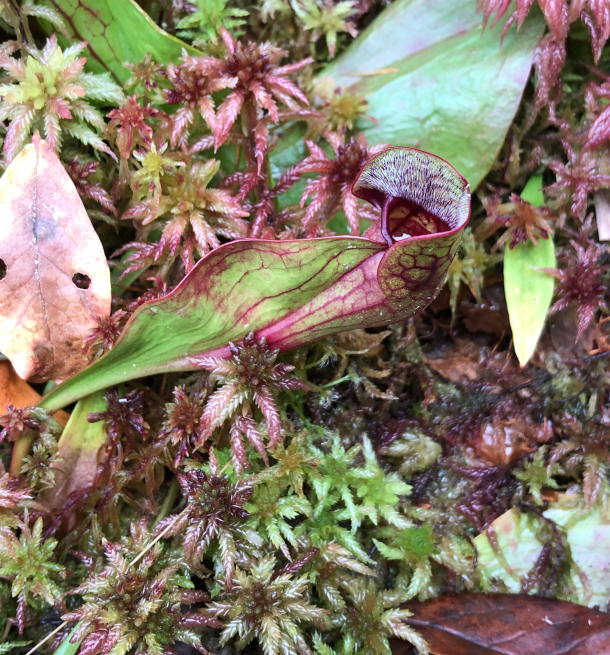
Wetland plants include carnivorous pitcher plants and peat-forming Sphagnum mosses (Photo: Louis Mallison)
DOERING: And it's so good at preserving things that you mentioned prehistoric specimens we've found, as well as human remains, that have been remarkably well preserved.
STRUZIK: Some of the stories are absolutely wonderful. I think there was a story in Denmark in the 1950s where some farmers dug up a body that was so perfectly preserved, they thought it was a murder victim, then they brought in the police, and then the police looked around and the forensics experts could find no evidence anywhere around of him being buried in any recent period of time. And then they brought in the archaeologists and the archaeologists looked at it and realized that, you know, this was an Iron Age human.
DOERING: Wow, that's incredible. So Iron Age, like literally thousands of years back, right?
STRUZIK: Yeah, some of these discoveries have actually, you know, forced historians to kind of rewrite the history of these places.
DOERING: Well, a lot of peat is locked up in permafrost and as the climate warms, it's thawing, and it's releasing the carbon that's stored there to the atmosphere, and that adds to even more warming, because carbon dioxide is a greenhouse gas. So given that we've already warmed the planet by about 1.1 degrees Celsius since pre-industrial times, how inevitable is this feedback loop?
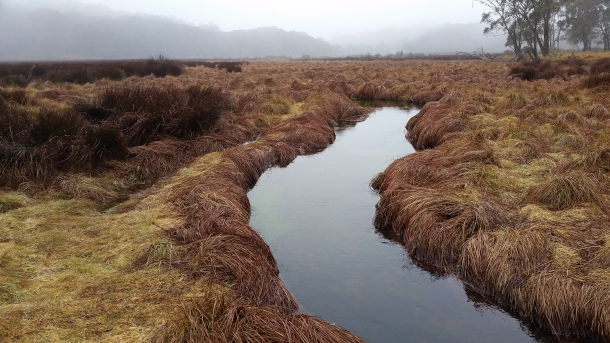
Peatlands have been historically drained by cutting canals through them to dry them out and convert the land for other uses (Photo: Doug Beckers, Flickr, CC BY-SA 2.0)
STRUZIK: Well, in some cases, it can't be reversed, we're going to lose an awful lot of permafrost at the southern edges of the permafrost regions. And the problem right now in the southern areas of the permafrost regions, we're seeing some places warming up faster than any other place on earth, and this permafrost is thawing extremely rapidly, so rapidly that the black spruce, it's a shallow-rooted spruce tree that roots itself in permafrost, when the permafrost actually thaws out, they have nothing to hang on to in the ground anymore and so they, you know, fall over, lean up against each other in what now we're calling drunken forests, found all over Alaska and northern Canada and Scandinavia. And now we're seeing that even at an advanced stage, they're no longer drunken forests, they're actually drowned forests, because there's so much moisture in permafrost, in some places it's 90%, so essentially, it's basically a big lake with a lot of dirt and peat in it, and once it starts to thaw out, it just basically turns back into that big lake that used to be there at one point. The good news, though, is that in many areas in the north, the permafrost is more than 100 feet deep in some places and it's going to take an awful lot of time for that to thaw out, you know. The important thing is we've got to protect these places because in those places the slightest disturbance such as, you know, building a new road, developing a mine, drilling for oil and gas disturbs that peat. Once the oxygen gets in there it starts warming things up and then that warm starts spreading. These peatlands store an enormous amount of carbon. If you think of the Hudson Bay lowlands in Canada, it stores five times more carbon than the equivalent in the Amazon Rainforest. And when you put it all together, peatlands represent just maybe 3% of the world's terrestrial surface, but they store twice as much carbon as all of the world's forests combined. So they are a wonderful storehouse for carbon.
DOERING: So often when we hear about nature-based climate solutions and carbon sequestration, it's all about tree planting and reforestation, but peatlands are even better at storing carbon, as you say. So to what extent should we be talking more about protecting and restoring existing peatlands as well?
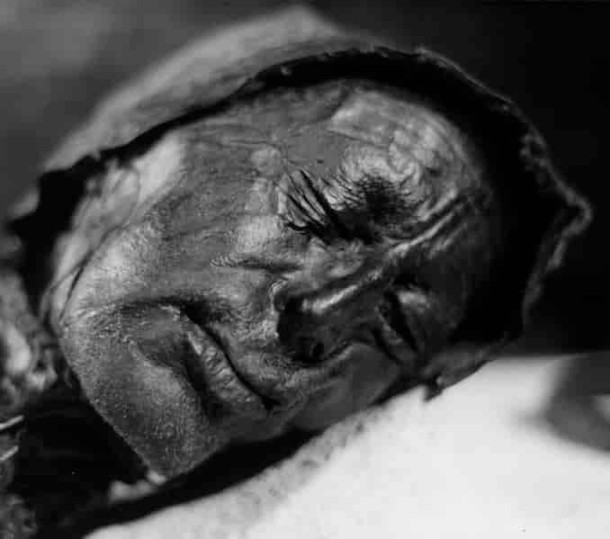
The oxygen-starved conditions of peatlands make them excellent at preserving remains, even humans such as the more than 1000 year old “Tollundmannen”, found in Denmark (Photo: Sven Rosborn, Store Norske Leksikon, public domain)
STRUZIK: Well, this is something that I've talked a lot about. I have nothing against growing trees, you know, they do an incredibly good job, you know, by cleaning the air, filtering water, and keeping nutrients in the soil. They provide fruit and root vegetables to plants, animals and humans and, so again, there's nothing wrong with it but if you want to get the bigger bang for your buck, I think you're much better off either restoring degraded peatlands or preserving those that already exist. Because when you think about it, you know, with all the wildfires that are occurring in the United States and Canada and throughout the world, a forest, you know, you can have 50 million trees burn down in two weeks. But it's really difficult to burn a healthy bog or fen. In fact, wildfire fighters will tell you that bogs and fens and swamps and marshes are their best friend because most fires, once they run up against these really moist conditions, they just stop or slow enough for them to get on top of it. So that's one of the, you know, the other services that they play. The other thing is that they don't like to have nitrogen and fertilizers as trees need to grow. So, you know, you spend an awful lot of money fertilizing a young tree and with water to get it going, where you really don't need to do that with a bog or a fen. You know, it's not the sexy thing that growing trees are. Everybody loves to plant a tree, but, you know, to plant a bog that's going to attract mosquitoes is not really quite as sexy.
DOERING: Right.
STRUZIK: And I guess the other thing that I'd like to say is that, you know, apart from slowing and stopping wildfires, and you consider as well that they can mitigate floods because they absorb so much moisture. They also do a wonderful job filtering water. And it's one of the reasons why we see the Great Lakes now growing so much blue algae. One of the reasons is that, you know, the Great Black Swamp in Ohio and Indiana was drained. And what they did in the past was all the water that went into the Great Lakes would be filtered by these peatlands and would come in very clean and cold. But without them now and with a lot of agriculture abutting those Great Lakes, all those nutrients, the fertilizers, are going straight into the Great Lakes, and with the Great Lakes warming, you're just getting these huge, huge algal blooms.
DOERING: Well, because we have drained so much of those peatlands that used to exist, and now we've built over them, and we've started farming on them too, to what extent can we bring them back? I mean, is it just a matter of re-wetting them and bringing the water back or what else needs to be done to restore them?
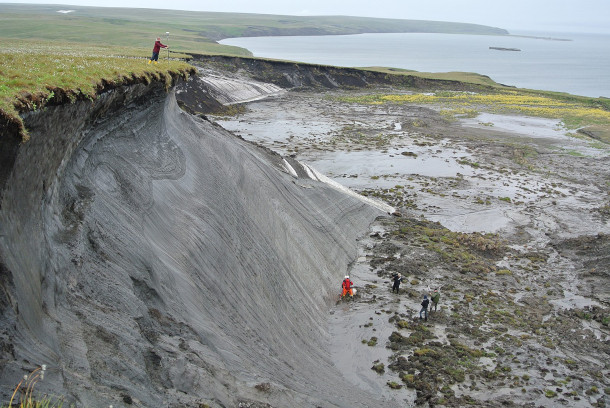
Permafrost, ground that is frozen year-round, can be more than 100 feet deep (Photo: Boris Radosavljevic, Wikimedia Commons, CC BY 2.0)
STRUZIK: Well, that's part of it. They're even doing it in the tar sands, because it's necessary, there's a law that says that they have to restore the tar sands back to the original peatlands that they were. They're not having a terrible amount of luck doing it because, you know, most places, they've mined down 100 feet to get at the bitumen, and it's pretty difficult to restore peatland in those conditions. I think, what our best bet really is, is to try to protect those peatlands that exist and that's the easiest, cheapest way of going about it because they're still doing a wonderful job, storing carbon and doing all of the other things that they do that help us.
DOERING: Edward Struzik is the author of "Swamplands: Tundra beavers, Quaking Bogs, and the Improbable World of Peat" among other books. Thank you so much, Ed.
STRUZIK: This was a lot of fun. Thank you.
Links
More of Edward Struzik’s books
Find the book “Swamplands” here (Affiliate link helps donate to LOE and local indie bookstores)
Living on Earth wants to hear from you!
Living on Earth
62 Calef Highway, Suite 212
Lee, NH 03861
Telephone: 617-287-4121
E-mail: comments@loe.org
Newsletter [Click here]
Donate to Living on Earth!
Living on Earth is an independent media program and relies entirely on contributions from listeners and institutions supporting public service. Please donate now to preserve an independent environmental voice.
NewsletterLiving on Earth offers a weekly delivery of the show's rundown to your mailbox. Sign up for our newsletter today!
 Sailors For The Sea: Be the change you want to sea.
Sailors For The Sea: Be the change you want to sea.
 Creating positive outcomes for future generations.
Creating positive outcomes for future generations.
 Innovating to make the world a better, more sustainable place to live. Listen to the race to 9 billion
Innovating to make the world a better, more sustainable place to live. Listen to the race to 9 billion
 The Grantham Foundation for the Protection of the Environment: Committed to protecting and improving the health of the global environment.
The Grantham Foundation for the Protection of the Environment: Committed to protecting and improving the health of the global environment.
 Contribute to Living on Earth and receive, as our gift to you, an archival print of one of Mark Seth Lender's extraordinary wildlife photographs. Follow the link to see Mark's current collection of photographs.
Contribute to Living on Earth and receive, as our gift to you, an archival print of one of Mark Seth Lender's extraordinary wildlife photographs. Follow the link to see Mark's current collection of photographs.
 Buy a signed copy of Mark Seth Lender's book Smeagull the Seagull & support Living on Earth
Buy a signed copy of Mark Seth Lender's book Smeagull the Seagull & support Living on Earth

